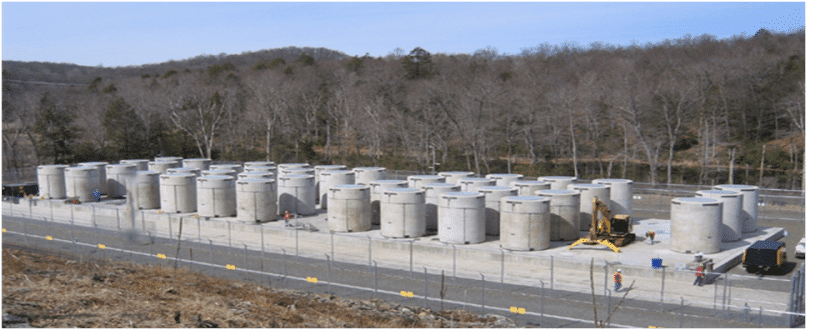The internet and major media are full of fables about nuclear energy. Unfortunately, this false information gets repeated so often that it becomes accepted truth by those who don’t know any better. The situation is made even more pernicious through promotion of falsehoods by celebrities and otherwise “reputable” people with dubious political agendas.
Disinformation about nuclear power plants is generally directed at plant safety, radiation emissions, detrimental effects on the environment, radioactive waste, and nuclear weapon proliferation. Some typical fables (i.e., false assertions) are presented here, along with brief discussions of the facts.
Fable #1
Nuclear power plants can explode like atomic bombs.
Facts: The nuclear fuel in U.S. nuclear power plants is low-enriched uranium, mostly fissionable (not capable of producing a self-sustaining chain reaction) uranium-238 atoms. Nuclear bombs use highly enriched uranium, mostly fissile (capable of producing a self-sustaining chain reaction) uranium-235 atoms.
In a uranium-235 (U-235) atomic bomb, the U-235 mass would be energetically formed into a supercritical configuration using high explosives so that as many as possible of the U-235 atoms fission before the energy release disassembles the unused U-235 mass. The nuclear detonation is over in about one microsecond.
The neutron population in a nuclear reactor core is controlled by using neutron-absorbing materials to ensure that the atoms fission in a controlled manner. Even in a melted condition, nuclear reactor fuel cannot achieve a supercritical configuration, which is a necessary condition for an atomic bomb. A rapid increase in reactor fission events would initiate physical state changes and chemical reactions that would quickly destroy the reactor core configuration and terminate the fission process.
Fable #2
Nuclear power plants are a radiation health hazard.
Facts: Nuclear power plant radiation emissions are both regulated and extremely low. There is no epidemiological evidence that low dose/dose rate ionizing radiation adversely affects human health or produces genetic defects.
As an interesting side note, both Grand Central Station and the base of the Statue of Liberty emit more ionizing radiation than regulators allow licensed nuclear power plants to emit. The granite in these structures emits alpha particles and gamma rays in the breakdown of isotopes it contains: potassium-40, thorium-232, uranium-238 and radon-222. The nearby public is regularly bombarded, yet neither of these structures are considered public health hazards.
In addition, coal-fired power plants emit more radiation than nuclear power plants because their radiation emissions are not regulated. And, interestingly enough, of all the coal plant emissions considered to be health hazards, radiation emissions are (rightly) not included.
Fable #3
Nuclear power plants are bad for the environment.
Facts: So-called renewable energy facilities require extremely large areas of land to produce the same electrical power output as nuclear power plants. Furthermore, life-cycle waste generation (per kWh of electricity produced) for nuclear power plants is neither more than less than that of “renewable” energy facilities. Per megawatt of electricity generated, nuclear power plants have one of the smallest physical footprints of all electricity-generating facilities.
Fable #4
Nuclear waste cannot be handled or stored safely.
Facts: Used nuclear power plant fuel is being safely stored and monitored at nuclear plant sites in dry-storage casks. The photograph below shows the used fuel, from 30 years of operation, being stored at the decommissioned Connecticut Yankee nuclear power plant site.

Only about 3% of this waste volume would need to be managed and stored as high-level nuclear waste if reprocessing of used fuel was permitted in the U.S. Long-term storage of high-level waste from nuclear fuel reprocessing is neither a technological nor a safety problem. It is purely a political problem in the U.S.
Fable #5
Nuclear fuel reprocessing will lead to proliferation of nuclear weapons.
Facts: The plutonium in used nuclear reactor fuel is not suited for use in nuclear weapons. Greater than 18% of plutonium generated in a normal light-water reactor fuel cycle is plutonium-240 (Pu-240), which spontaneously fissions, thereby creating fission neutrons. A nuclear weapon must contain less than 7 percent Pu-240 so that significant Pu-239 (the fissile isotope of plutonium) fission does not occur before a supercritical configuration is achieved, a necessary condition for an atomic bomb.
Furthermore, to make reactor-grade plutonium into weapon-grade plutonium is both impractical and dangerous. Pu-240 has a fairly high spontaneous fission rate, making it a relatively strong neutron emitter, and neutron radiation is more biologically harmful than gamma-ray radiation. Pu-241, another plutonium isotope in used nuclear fuel, decays to americium-241, which is a strong alpha radiation source that poses self-heating and radiotoxicity problems if inhaled or ingested.
Related Articles:
Dispelling Irrational Fear of Radiation
Understanding Radiation Risks & Benefits
The Dynamic World of Radioactive Decay
Latest Low-dose Radiation Research Program a Retread?
